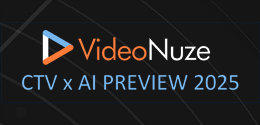-
Data, Monetization, and Viewership Trends Across the Video Landscape
Thursday, May 11, 2017, 11:21 AM ETPosted by:Speed and growth. Two themes that publishers leveraging video really care about. In 2017, so far, publishers are using more sophisticated tools to measure, automate, and improve processes. In fact, using data and automation for video to drive larger, more engaged audiences and more effective monetization, is more important than ever.
However, buzzwords don’t push the needle. Driving video business in the real world comes with a host of challenges, and fragmented efforts often tamp down any real growth.
Categories: Technology
Topics: JW Player
-
Publishers: Prepare for Connected TV
Thursday, March 23, 2017, 10:39 AM ETPosted by:There’s been a lot of hype over the past few years how TV broadcasters need to be cognizant of second screens like smartphones and tablets that can distract viewers. Now the first screen is getting revenge.
Facebook, for one, is said to be developing a video-centric app for TV set-top boxes that would bring its content to TV. The move comes as the digital video ad market is projected to double by 2019 and publishers have been strongly pushing video ad inventory.
For younger consumers in particular, the distinction between screens is irrelevant. About half of consumers watch movies and TV over the Internet daily. Some 63% of Americans own an Internet-connected TV.Categories: Devices
Topics: Smart AdServer
-
CPMs Will Increase for Programmatic Video
Tuesday, February 7, 2017, 1:06 PM ETPosted by:Supply-side platforms (SSPs) love to tout unique and premium video inventory. The reality is premium video inventory is scarce, and unique premium video inventory is even more rare.
To put it another way, “if you’re a content company and you’re not Facebook, Google, and Snapchat, you’re in the niche ad business,” said Meredith Kopit Levien, EVP and CRO of The New York Times. The good news: Scarcity is a good thing.Categories: Advertising, Programmatic
Topics: DashBid
-
Remembering the Basics is Critical for TV to Succeed In a "Technology Everywhere” World
Thursday, February 2, 2017, 11:46 AM ETPosted by:America’s broadcasting and cable companies have a rich history of creating great content and delivering large audiences that advertisers covet. They also perfected a direct sales supply and demand business model that has, for the most part, survived the digital invasion. But things have changed…
Digital disruption has rippled across the media landscape for over two decades now, and while television has fared better than their print media counterparts, accelerated disruption from Facebook and others is now hitting video publishers harder than ever. Much of the disruption falls into three categories:Categories: Advertising
Topics: Mixpo
-
Going Flash-Free with Video: Transitioning Successfully
Tuesday, January 17, 2017, 10:29 AM ETPosted by:As web browsers move rapidly to sunset their support for Flash, companies that rely on Flash for video playback are being forced to make changes. Apple has led the charge in driving the need for this change by disabling Flash by default in Safari 10, and Chrome, Firefox, and Microsoft’s Edge are quickly following suit. Some media companies migrated to HTML5 video players in early 2016 in anticipation of these industry-wide changes, but others have remained in a ‘wait-and-see’ mode to see if Flash really is going away.
Companies that haven’t moved to an HTML5 video player are now stuck between a rock and a hard-place. For them, its either risk the impact of Flash being disabled and react as needed, or remove this risk at the expense of making this migration an immediate priority. The reticence of those that remain reliant on Flash has to do with not being able to properly evaluate the risk and effort involved.Categories: Technology
-
5 Video Ad Market Predictions for 2017
Monday, December 19, 2016, 9:11 AM ETPosted by:Convergence has been one of the main themes in video during 2016, as more content traditionally delivered via broadcast channels is being converted to digital streams. The marketplaces of the future - programmatic or otherwise - are beginning to form as media owners piece together a range of sales techniques to maximize their yield. Some of the big trends and changes we expect to see in 2017 are:
Categories: Advertising, Devices, Programmatic
Topics: SpotX
-
Metadata, Content Discovery and the Future of Audience Engagement
Tuesday, November 15, 2016, 8:40 AM ETPosted by:The television viewing experience has changed dramatically over the last few years, moving from a TV set in the living room to mobile devices with HD screens that travel wherever you go. Not only has the device that we watch TV on changed, but the dynamic of how we watch has also undergone a fundamental change. TV viewing is no longer a family activity, with multiple family members watching the same show. Rather, it’s now an individual activity, with different members of the family watching different programming at the same time, often in the same room.
For content distributors and programmers, the effects of this shift are further exacerbated due to the sheer volume of quality video content being produced and widely available to consumers.Categories: Video Search
Topics: Piksel
-
How Recommendation Technology Is Evolving to Meet Customer Expectations
Thursday, November 3, 2016, 8:53 AM ETPosted by:In the media business, content is king, so content traditionally (and understandably) takes priority over user experience. But priorities are shifting as streaming evolves into a more complex, competitive space where differentiated products can make a big difference to the bottom line.
To truly personalize discovery, Comcast is investing heavily in improving how its customers search and browse content. And by valuing its personalization tech at $1 billion a year, Netflix firmly established that a truly personalized entertainment platform presents large opportunities for companies trying to hit the moving target of user expectations.Categories: Technology
Topics: MediaHound










